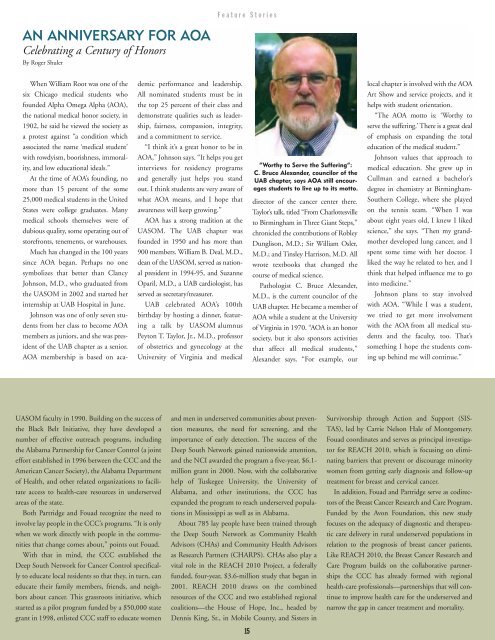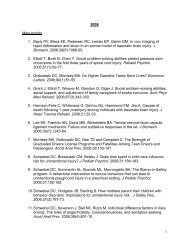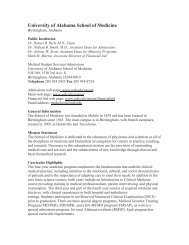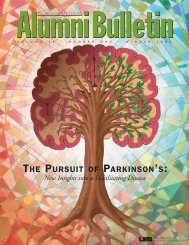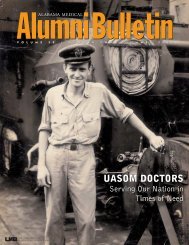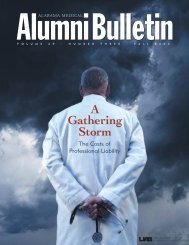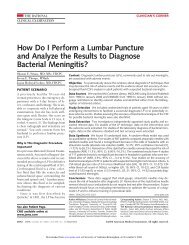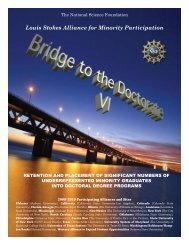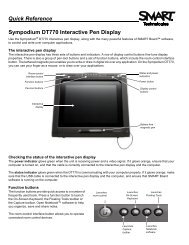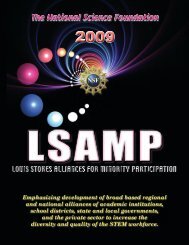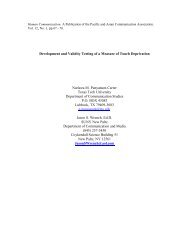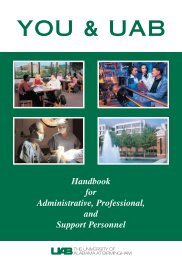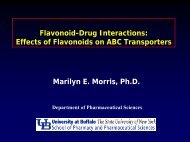AlumniBulletin - University of Alabama at Birmingham
AlumniBulletin - University of Alabama at Birmingham
AlumniBulletin - University of Alabama at Birmingham
Create successful ePaper yourself
Turn your PDF publications into a flip-book with our unique Google optimized e-Paper software.
AN ANNIVERSARY FOR AOA<br />
Celebr<strong>at</strong>ing a Century <strong>of</strong> Honors<br />
By Roger Shuler<br />
Fe<strong>at</strong>ure Stories<br />
When William Root was one <strong>of</strong> the<br />
six Chicago medical students who<br />
founded Alpha Omega Alpha (AOA),<br />
the n<strong>at</strong>ional medical honor society, in<br />
1902, he said he viewed the society as<br />
a protest against “a condition which<br />
associ<strong>at</strong>ed the name ‘medical student’<br />
with rowdyism, boorishness, immorality,<br />
and low educ<strong>at</strong>ional ideals.”<br />
At the time <strong>of</strong> AOA’s founding, no<br />
more than 15 percent <strong>of</strong> the some<br />
25,000 medical students in the United<br />
St<strong>at</strong>es were college gradu<strong>at</strong>es. Many<br />
medical schools themselves were <strong>of</strong><br />
dubious quality, some oper<strong>at</strong>ing out <strong>of</strong><br />
storefronts, tenements, or warehouses.<br />
Much has changed in the 100 years<br />
since AOA began. Perhaps no one<br />
symbolizes th<strong>at</strong> better than Clancy<br />
Johnson, M.D., who gradu<strong>at</strong>ed from<br />
the UASOM in 2002 and started her<br />
internship <strong>at</strong> UAB Hospital in June.<br />
Johnson was one <strong>of</strong> only seven students<br />
from her class to become AOA<br />
members as juniors, and she was president<br />
<strong>of</strong> the UAB chapter as a senior.<br />
AOA membership is based on academic<br />
performance and leadership.<br />
All nomin<strong>at</strong>ed students must be in<br />
the top 25 percent <strong>of</strong> their class and<br />
demonstr<strong>at</strong>e qualities such as leadership,<br />
fairness, compassion, integrity,<br />
and a commitment to service.<br />
“I think it’s a gre<strong>at</strong> honor to be in<br />
AOA,” Johnson says. “It helps you get<br />
interviews for residency programs<br />
and generally just helps you stand<br />
out. I think students are very aware <strong>of</strong><br />
wh<strong>at</strong> AOA means, and I hope th<strong>at</strong><br />
awareness will keep growing.”<br />
AOA has a strong tradition <strong>at</strong> the<br />
UASOM. The UAB chapter was<br />
founded in 1950 and has more than<br />
900 members. William B. Deal, M.D.,<br />
dean <strong>of</strong> the UASOM, served as n<strong>at</strong>ional<br />
president in 1994-95, and Suzanne<br />
Oparil, M.D., a UAB cardiologist, has<br />
served as secretary/treasurer.<br />
UAB celebr<strong>at</strong>ed AOA’s 100th<br />
birthday by hosting a dinner, fe<strong>at</strong>uring<br />
a talk by UASOM alumnus<br />
Peyton T. Taylor, Jr., M.D., pr<strong>of</strong>essor<br />
<strong>of</strong> obstetrics and gynecology <strong>at</strong> the<br />
<strong>University</strong> <strong>of</strong> Virginia and medical<br />
“Worthy to Serve the Suffering”:<br />
C. Bruce Alexander, councilor <strong>of</strong> the<br />
UAB chapter, says AOA still encourages<br />
students to live up to its motto.<br />
director <strong>of</strong> the cancer center there.<br />
Taylor’s talk, titled “From Charlottesville<br />
to <strong>Birmingham</strong> in Three Giant Steps,”<br />
chronicled the contributions <strong>of</strong> Robley<br />
Dunglison, M.D.; Sir William Osler,<br />
M.D.; and Tinsley Harrison, M.D. All<br />
wrote textbooks th<strong>at</strong> changed the<br />
course <strong>of</strong> medical science.<br />
P<strong>at</strong>hologist C. Bruce Alexander,<br />
M.D., is the current councilor <strong>of</strong> the<br />
UAB chapter. He became a member <strong>of</strong><br />
AOA while a student <strong>at</strong> the <strong>University</strong><br />
<strong>of</strong> Virginia in 1970. “AOA is an honor<br />
society, but it also sponsors activities<br />
th<strong>at</strong> affect all medical students,”<br />
Alexander says. “For example, our<br />
local chapter is involved with the AOA<br />
Art Show and service projects, and it<br />
helps with student orient<strong>at</strong>ion.<br />
“The AOA motto is: ‘Worthy to<br />
serve the suffering.’ There is a gre<strong>at</strong> deal<br />
<strong>of</strong> emphasis on expanding the total<br />
educ<strong>at</strong>ion <strong>of</strong> the medical student.”<br />
Johnson values th<strong>at</strong> approach to<br />
medical educ<strong>at</strong>ion. She grew up in<br />
Cullman and earned a bachelor’s<br />
degree in chemistry <strong>at</strong> <strong>Birmingham</strong>-<br />
Southern College, where she played<br />
on the tennis team. “When I was<br />
about eight years old, I knew I liked<br />
science,” she says. “Then my grandmother<br />
developed lung cancer, and I<br />
spent some time with her doctor. I<br />
liked the way he rel<strong>at</strong>ed to her, and I<br />
think th<strong>at</strong> helped influence me to go<br />
into medicine.”<br />
Johnson plans to stay involved<br />
with AOA. “While I was a student,<br />
we tried to get more involvement<br />
with the AOA from all medical students<br />
and the faculty, too. Th<strong>at</strong>’s<br />
something I hope the students coming<br />
up behind me will continue.”<br />
UASOM faculty in 1990. Building on the success <strong>of</strong><br />
the Black Belt Initi<strong>at</strong>ive, they have developed a<br />
number <strong>of</strong> effective outreach programs, including<br />
the <strong>Alabama</strong> Partnership for Cancer Control (a joint<br />
effort established in 1996 between the CCC and the<br />
American Cancer Society), the <strong>Alabama</strong> Department<br />
<strong>of</strong> Health, and other rel<strong>at</strong>ed organiz<strong>at</strong>ions to facilit<strong>at</strong>e<br />
access to health-care resources in underserved<br />
areas <strong>of</strong> the st<strong>at</strong>e.<br />
Both Partridge and Fouad recognize the need to<br />
involve lay people in the CCC’s programs. “It is only<br />
when we work directly with people in the communities<br />
th<strong>at</strong> change comes about,” points out Fouad.<br />
With th<strong>at</strong> in mind, the CCC established the<br />
Deep South Network for Cancer Control specifically<br />
to educ<strong>at</strong>e local residents so th<strong>at</strong> they, in turn, can<br />
educ<strong>at</strong>e their family members, friends, and neighbors<br />
about cancer. This grassroots initi<strong>at</strong>ive, which<br />
started as a pilot program funded by a $50,000 st<strong>at</strong>e<br />
grant in 1998, enlisted CCC staff to educ<strong>at</strong>e women<br />
and men in underserved communities about prevention<br />
measures, the need for screening, and the<br />
importance <strong>of</strong> early detection. The success <strong>of</strong> the<br />
Deep South Network gained n<strong>at</strong>ionwide <strong>at</strong>tention,<br />
and the NCI awarded the program a five-year, $6.1-<br />
million grant in 2000. Now, with the collabor<strong>at</strong>ive<br />
help <strong>of</strong> Tuskegee <strong>University</strong>, the <strong>University</strong> <strong>of</strong><br />
<strong>Alabama</strong>, and other institutions, the CCC has<br />
expanded the program to reach underserved popul<strong>at</strong>ions<br />
in Mississippi as well as in <strong>Alabama</strong>.<br />
About 785 lay people have been trained through<br />
the Deep South Network as Community Health<br />
Advisors (CHAs) and Community Health Advisors<br />
as Research Partners (CHARPS). CHAs also play a<br />
vital role in the REACH 2010 Project, a federally<br />
funded, four-year, $3.6-million study th<strong>at</strong> began in<br />
2001. REACH 2010 draws on the combined<br />
resources <strong>of</strong> the CCC and two established regional<br />
coalitions—the House <strong>of</strong> Hope, Inc., headed by<br />
Dennis King, Sr., in Mobile County, and Sisters in<br />
15<br />
Survivorship through Action and Support (SIS-<br />
TAS), led by Carrie Nelson Hale <strong>of</strong> Montgomery.<br />
Fouad coordin<strong>at</strong>es and serves as principal investig<strong>at</strong>or<br />
for REACH 2010, which is focusing on elimin<strong>at</strong>ing<br />
barriers th<strong>at</strong> prevent or discourage minority<br />
women from getting early diagnosis and follow-up<br />
tre<strong>at</strong>ment for breast and cervical cancer.<br />
In addition, Fouad and Partridge serve as codirectors<br />
<strong>of</strong> the Breast Cancer Research and Care Program.<br />
Funded by the Avon Found<strong>at</strong>ion, this new study<br />
focuses on the adequacy <strong>of</strong> diagnostic and therapeutic<br />
care delivery in rural underserved popul<strong>at</strong>ions in<br />
rel<strong>at</strong>ion to the prognosis <strong>of</strong> breast cancer p<strong>at</strong>ients.<br />
Like REACH 2010, the Breast Cancer Research and<br />
Care Program builds on the collabor<strong>at</strong>ive partnerships<br />
the CCC has already formed with regional<br />
health-care pr<strong>of</strong>essionals—partnerships th<strong>at</strong> will continue<br />
to improve health care for the underserved and<br />
narrow the gap in cancer tre<strong>at</strong>ment and mortality.


